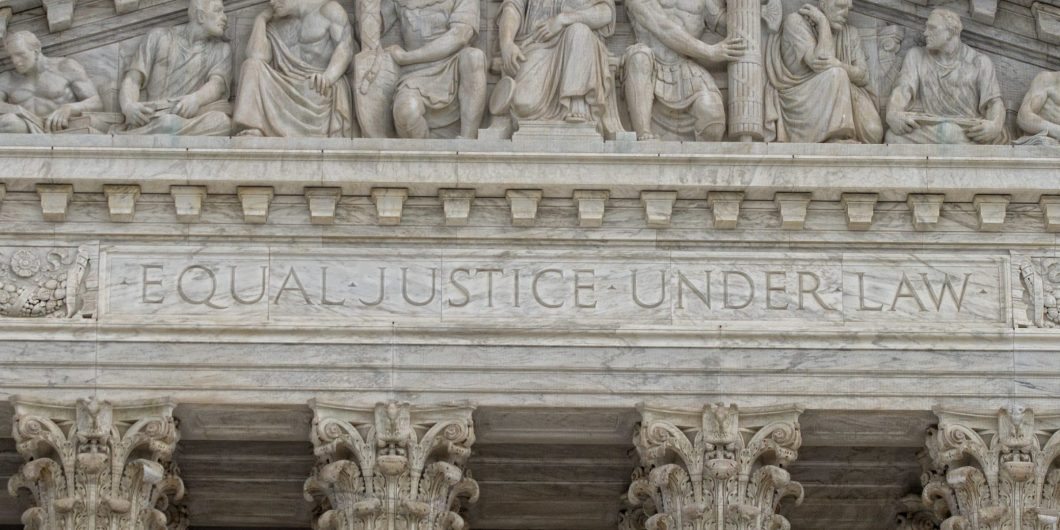What would an action program renouncing ethnic categories and embracing individualistic liberalism look like?
Constitutional Disparate Impact: Woke Lochnerism?
On the heels of a global pandemic and upheaval following the grisly death of George Floyd, opportunists have seized the moment to fundamentally “restructure” society towards their outré visions of racial justice. While there are many plans for social engineering by way of the administrative state, an even more powerful and universal approach is just waiting to be adopted by a future liberal Supreme Court majority. The Court’s “Disparate Impact” (DI) doctrine, if constitutionalized and thereby expanded into new areas of law, could herald an unprecedented transformation in American society and the balance of government power.
A primer on DI is in order. The doctrine was contrived, without jurisprudential basis, in Griggs v. Duke Power Co. (1971). Congress subsequently codified it in the 1991 Civil Rights Act. The formula provides that an employer’s lack of discriminatory intent does not bar liability in employment actions. Plaintiffs make out a prima facie case of discrimination when they prove an employment selection device yields a disparate impact, generally as defined by the EEOC’s 4/5 rule which requires the success rate of one protected group be no less than 80% of another. For instance, a personnel selection test that produces a pass rate of 60% for all Hispanic applicants and only 20% for all whites would fall short of this standard. Once the prima facie case is satisfied, the burden shifts to defendants to prove their practice is “manifestly job related” or consistent with “business necessity”. Even so, defendants might still be found liable if they refuse to adopt “less discriminatory alternatives” that still effectively serve their interests.
Proponents argue that the difficulty of proving invidious intent renders DI indispensable. On their account, a focus on intent alone fails to grasp the true nature of modern oppression, where ‘unconscious bias’—or sheer inertia— creates laws and social practices that collude against minorities.
Moreover, a recent article in Slate, urging the overturning of Washington v. Davis, previews the legal left’s trajectory. In Washington, the Court declined to engraft DI onto the Fifth or Fourteenth Amendments, requiring plaintiffs to establish discriminatory treatment to prove a constitutional violation. The far-reaching nature of a potentially constitutionalized DI cannot be overstated. All manner of “measures always considered to be constitutionally valid, such as sales taxes, state university tuition, and criminal penalties” would be called into question.
While DI is, in theory, designed to protect minorities, it doesn’t always do so. Rather than obsessively latching onto racial statistics alone, normal people use more holistic criteria to evaluate government policies. In fact, groups bearing the brunt of disparities often support laws that bring about inequality on independent grounds. For example, pace the press, many residents of high-crime areas support broken-windows policing and similar policies that provide for public safety.
Likewise, the crack-cocaine sentencing disparity and the 1994 Crime Bill netted immense black support due to unparalleled violent crime preceding these enactments. Community leaders likely knew these laws would bear more heavily on blacks, but the price of inaction was too high. Constitutional DI, however, would tilt the scales, allowing judges to second-guess such cost-benefit analyses that, in their view, accord insufficient weight to inequality. Perversely, this legal makeweight discounts the views of its purported beneficiaries.
Were constitutional DI instantiated in Fourteenth Amendment jurisprudence, plenty more popular measures would also be on the chopping block, though their nexus to race might not be obvious. Environmental regulations (like the Endangered Species Act), land-use restrictions, and health and safety ordinances drive up housing costs, disproportionately impacting minorities. In Magner v. Gallagher, inspectors at the City of St. Paul faced DI liability for vigorously enforcing fire safety codes against local slumlords. Wisely, the Obama DOJ forced a settlement before the case reached the Supreme Court.
Individual liberty and social harmony are incompatible with a legal regime that demands monomaniacal head-counting of racial representation in every facet of life.
As the Equal Protection Clause applies to all “persons” within a state’s jurisdiction, myriad progressive measures that implicate whites would also be in jeopardy. It is not inconceivable that a judge with a dim view of estate taxes might conjure up a less discriminatory means of generating government revenue.
As the policy field potentially subject to DI inquiry is vast, judges would effectively wield carte blanche to countermand government action at all levels (from Congress to local school boards) whenever a law fails to meet their vision of “policy necessity” or they divine a “less discriminatory alternative”.
In Title VII cases, the Supreme Court has not clarified the “business necessity” standard, giving lower courts wide berth to map its contours. Some proposed standards are so exacting as to require that, without a particular practice, a defendant’s business would go under. Others would merely call for proof that a practice is consonant with profitability. The job-relatedness prong is plagued by similar jurisprudential confusion. There is no reason to believe this situation would improve were DI extended into the constitutional realm.
In fact, due to broad discretion in the “policy necessity” inquiry, Constitutional DI might beget a juristocracy worse than that of the Lochner Era. There, the Court annulled public welfare measures deemed to contravene a nebulous “liberty of contract.” This naked arrogation of power was justified through claims that laissez-faire and “anti-factionalism” were deeply-rooted constitutional values. Only this time, kritarchs will rationalize the elevation of the judiciary to national public-policy veto-holder by trussing up woke orthodoxies as fundamental constitutional principles.
It is true that, when evaluating laws under strict scrutiny, courts already pass judgment on whether government interests are sufficiently compelling. However, unlike constitutional DI, the policy field subject to this strict scrutiny is limited to a narrow range of constitutional questions. Indeed, even when considering such cases, courts often dispense judgments without reaching this assessment. The Supreme Court has not developed a hierarchy of government interests, as such a project is fraught with political considerations. But constitutionalized DI brings this inquiry to the fore, potentially further undermining judicial legitimacy. True, certain laws would be deemed unambiguously necessary (e.g.: laws against murder, rape etc.), but a vast twilight zone exists.
The “less discriminatory alternative” prong further expands judicial discretion. Determining ex ante whether an employment practice generates less discrimination and is equally effective is already difficult. An employer needs predictive models, pilot tests, and reams of validated psychological research. How a judge could make this determination in the constitutional arena—recalibrating laws to diminish DI but maintain effectiveness—is a mystery. The judiciary would transmogrify into little more than a policymaking super-legislature.
Even in the employment context, the pervasiveness of group differences has proved incompatible with the lofty ideals of DI. Decades-long efforts of industrial-organizational psychologists to fine-tune selection tests and stave off employer liability have run up against the iron law of personnel selection, whereby a tradeoff exists between the validity of selection devices (i.e., their ability to predict job-performance) and racial diversity.
A regime of constitutional DI—and pervasive and permanent racial quotas—would resemble a Harrison Bergeron-esque constitution: individual liberty utterly sacrificed at the altar of absolute equality of outcome. The legal left’s vision leaves self-government at the whims of a cadre of antiracist judges and bureaucrats.
Individual liberty and social harmony are incompatible with a legal regime that demands monomaniacal head-counting of racial representation in every facet of life. In fact, DI itself violates equal protection. Incentives to preempt DI liability “put undue pressure on employers to adopt inappropriate prophylactic measures” like hidden quotas or race-norming. Moreover, court-ordered remedies to Disparate Impact create a civil rights catch-22 for employers: violate either disparate impact or disparate treatment. Courts should abandon—not redouble—such invidious racial balancing acts.
The Fourteenth Amendment does not enact Ibram X. Kendi’s How to Be an Antiracist. The Constitution, and American society, guarantee “equal laws, not equal results.”


